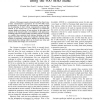Free Online Productivity Tools
i2Speak
i2Symbol
i2OCR
iTex2Img
iWeb2Print
iWeb2Shot
i2Type
iPdf2Split
iPdf2Merge
i2Bopomofo
i2Arabic
i2Style
i2Image
i2PDF
iLatex2Rtf
Sci2ools
VTC
2008
IEEE
2008
IEEE
Channel Model for Train to Train Communication Using the 400 MHz Band
Abstract—This paper presents a channel model for direct trainto-train communication appropriate for the 400 MHz band. Extrapolation of theoretical and experimental results obtained for the planning of other railway communication systems like GSM-R is not obvious due to the difference in frequencies, antenna height and absence of base stations. In this paper, the analysis of the channel model covers different radio phenomena including path loss, Doppler, fading, and delay spread. Concretely we consider three scenarios (train stations, shunting yards and regional networks), for which the propagation channel characteristics are discussed. Furthermore, influence of special railway environments like cuttings which can be found near cities and towns, tunnels and bridges are encountered.
Channel Model | Communications | Direct Trainto-train Communication | Railway Communication Systems | VTC 2008 |
| Added | 01 Jun 2010 |
| Updated | 01 Jun 2010 |
| Type | Conference |
| Year | 2008 |
| Where | VTC |
| Authors | Cristina Rico Garcia, Andreas Lehner, Thomas Strang, Korbinian Frank |
Comments (0)

